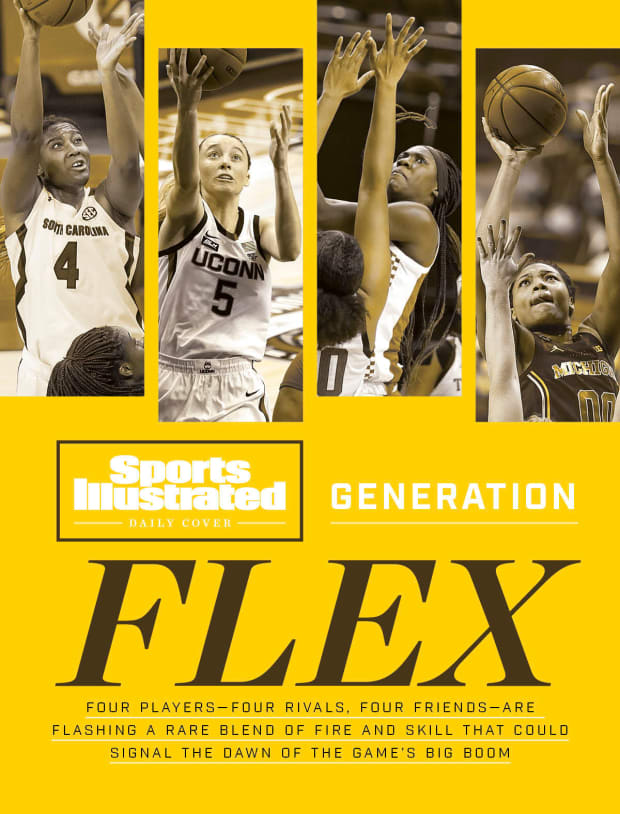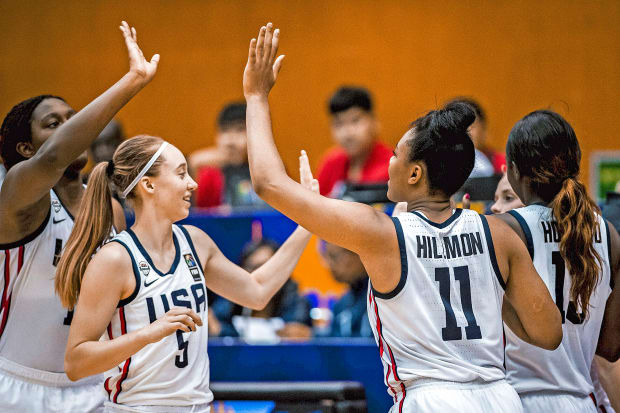Four players—four rivals, four friends—are flashing a rare blend of impossible-to-ignore fire and skill that could signal the dawn of a big women's basketball boom.
Eras tend to get labeled as such after the fact, from a safe distance. But occasionally the evidence of something new piles up so quickly and conspicuously that it can’t be missed, even in the moment. If you were looking for the start of the next chapter in the quickening plot of women’s basketball, you might reasonably pick out the first month of 2021, which a rare generation of collegians spent doing rare things.
Against Mississippi State on Jan. 3, 6' 2" guard Rhyne Howard of Kentucky—a top Player of the Year contender and a would-be first pick in the upcoming WNBA draft, if juniors were eligible—scored 25 of her 33 points in the fourth quarter and overtime, erasing a late deficit seemingly by sheer force of will in a 92–86 victory. On the afternoon of Jan. 21, Naz Hillmon, a junior for Michigan, put up 50 in a four-point loss to Ohio State—the most from any player this season, but not so unusual for a 6' 2" forward with a pair of 35-point games in the previous two months. That same evening, in a 62–50 win over Georgia, 6' 5" South Carolina sophomore Aliyah Boston dropped a nonclassical triple double: 16 points, 11 rebounds, 10 blocks. And on the last day of that month, heavily hyped UConn freshman point guard Paige Bueckers piled up 25 points and 12 assists in a blowout of DePaul, her first double double in what is expected to be an extensive catalog.
The game has seen blooms of talent before. As recently as the late 2000s, Maya Moore, Candace Parker and Sylvia Fowles offered an amateur preview of the Minnesota Lynx–L.A. Sparks rivalry that would captivate WNBA fans for the better part of a decade. But in its depth and breadth, today’s cluster of ascendant stars suggests something even more exciting: a sport settling into a golden age. “This generation has only seen the WNBA—they’ve grown up watching it, wanting to be a part of it and working on their games,” says Dawn Staley, a Hall of Famer in that league and now Boston’s coach. “This is the way it’s supposed to be. We’ve got this generational talent coming behind us because [we] were the carrot dangled in front of them.”

Inspiration has become self-sustaining. In 2019, Howard, Hillmon, Boston and Bueckers played for the U.S. national team, taking the gold medal in the U-19 World Cup in Thailand. Since then they have maintained a cross-country bond familiar to athletes of a certain caliber. “Whenever we talk, we’re hyping each other up,” says Howard. “Can I be like you? You’re such a GOAT.” If the pattern holds, they’ll stand as one another’s biggest obstacles for the next decade-plus, battling for individual honors, college championships, All-Star berths and WNBA titles.
But as a group they’ve already reshaped the conversation around the college game. In the past the national focus has tended to reduce to a central story line or athlete—say, Connecticut’s dominance, or the ability and celebrity of Sabrina Ionescu. This year’s NCAA tournament in San Antonio arrives with the spotlight spread across the country. “You watch Naz play, you want to watch every game,” says Kim Barnes Arico, Hillmon’s coach at Michigan. “You watch Paige, Rhyne, Aliyah play, you feel the same way. They’re dynamic. They’re impactful. They’re changing the landscape of women’s basketball.”
The players had connected, in various configurations, before rendezvousing in Colorado Springs over the summer of 2019—the small-world circuit of elite AAU basketball saw to that. But following someone on Instagram is not the same as guarding her for a week of training camp with the national team. Howard and Hillmon arrived that July fresh off winning their conference’s Freshman of the Year awards (despite being something short of blue-chippers, ranked 32nd and 58th in the class). Boston and Bueckers hadn’t yet matriculated, but their high school exploits and commitments to two of the sport’s elite programs had expectations cranked high. The previous U.S. U-19 team, at the ’17 World Cup, had lost in the final to Russia. This squad was tasked with restoring order.
The four relished being matched up in practice, Howard and Bueckers testing each other in full-court-dribble drills, Hillmon and Boston shouldering into each other on the blocks. (Hillmon’s takeaway from her time pulling Boston duty? “She’s extremely strong.”) Away from the gym, the teammates filled in the experiential gaps that online acquaintance leaves. The national team tour took them from Colorado to an exhibition run in Japan to, eventually, Bangkok, for the World Cup, where they filled their social feeds with poses of escalating goofiness and laughed so loudly at team dinners that coaches cast apologetic glances to neighboring tables. Upon learning that the rooms at one Tokyo hotel came equipped with bidets, they raced from suite to suite seeing whether their streams could arc all the way across the bathrooms, to the showers.

While even the most talented all-star teams can fall victim to halting play and bouts of your turn/my turn deference, this one developed rapport. Howard set the pace and picked out angles; Hillmon and Boston commandeered the paint; Bueckers slipped into open space and deposited jumpers. Each of the four led the team in a major statistical category: Howard in points, Bueckers assists, Hillmon rebounds and Boston blocks. In the tense moments of the late rounds—Howard bloodied her nose, drawing an unsportsmanlike foul, during an overtime win over Australia in the final—this synergy shone through. “There was a willingness to share the ball,” says UCLA coach Cori Close, a U-19 assistant. “They could stretch the court and attack off the pass or off the bounce. We had that rare combination of versatility and unselfishness.”
After reclaiming gold, the four players returned to their hometowns and campuses to prep for the next college season. Some athletes might have found this experience—a trip around the world, culminating in an every-other-day tournament against best-in-class competition—to be worthy of a recovery period. This group, though, insists on the opposite. It enlivened them, assured them of their place at the moment and steeled them for the future. “If I can guard Aliyah Boston in scrimmage,” says Hillmon, “I ought to be able to guard anyone.”
Confidence has since given way to something like mastery. Hillmon’s 44.5 player-efficiency rating this season nearly doubles that of other presumptive All-Americas, putting her in the rarefied category of senior-year Breanna Stewart (47.8) and A’ja Wilson (45.4). In February the 5' 11" Bueckers ripped off three straight 30-point games, becoming the first player in UConn’s storied history to do so. Howard scarcely goes mentioned by coaches without comparison to Maya Moore—smooth is the byword. And Boston, with her defensive foresight, evokes for Staley a certain three-time WNBA MVP: “She’s smart like Lisa Leslie.”
“Another group like this one doesn’t come to mind,” says analyst Andraya Carter, a former Tennessee player. “It’s guards, it’s posts. I don’t think we’ve ever had this overarching versatility and skill across the board, at so many different positions and so many different schools.”
Numbers and names, though, only partly cover what makes this crop special; nothing can substitute for tuning in and seeing for yourself. Howard has every move and counter in the book, but where she shines is in inventing, seemingly on the spot, some wrinkle on hoops standards. (In a January game against South Carolina, she edged past an off-ball screen, caught a pass, halted all momentum and thrust herself back into a one-legged, eight-foot fadeaway that danced on the front rim and dropped in—maybe the most skill-packed split second of this season.) Hillmon approaches the sport with functional ambidexterity and a Rodinesque eye for the telling detail; Barnes Arico marvels at her ability to spot an opponent’s weakness in the film room, design a countermeasure on the practice floor and deploy it in a game. Boston talks and plays like a bouncer. (“My physicality,” she says, “might make you want to back up. I don’t want to be a part of this.”) And Bueckers is all patience and guile—until she raises up for a jumper, at which point the ball is off her fingertips before her defender can lift an arm.
Among them, this season has resembled a series of escalating dares. Their dialogue—a cross-country string of texts, Snapstreaks and FaceTime dance-offs—is all about sharpening the knife’s edge of confidence and competitive envy on which the best players balance. They build one another up in one breath and lay down challenges in the next. After an early-season scoring outburst, Howard’s phone buzzed. “Oh, so you dropped 30?” Boston asked on the other end. “You think you’re going to do that against us?” (Howard did go for 32 against South Carolina on Jan. 10, but Boston sent back seven Wildcats shots, including a fourth-quarter Howard layup, helping preserve a Gamecocks win.)
All four players have landed on the late-season Wooden Award watch list, but Boston believes the group has an opportunity to do more than amass trophies. She observes with frustration a tendency, among fans and the press, to shrink a season down to a lone story line, a morsel set next to the glut of men’s coverage. “We’re going to force that to change,” Boston says. “You can’t keep all this under; there’s just too much talent. You’re going to have to cover it. We’re going to make sure that happens.”
This time a year ago, the basketball world lamented the cancellation of the NCAA tourney largely on one player’s behalf. oregon’s sabrina ionescu deserved a better send-off, read a characteristic headline, keeping with a historical pattern around women’s basketball of reductive hyperbole, a focus on specific excellence that, through no fault of its object, blots out broader goings-on. Any reader of any sports page knew Ionescu, the Kobe-anointed superstar piling up triple doubles. Far fewer, though, might have guessed that Boston’s Gamecocks, not Ionescu’s Ducks, ended the year No. 1 in the country. “We’re not a part of that narrative,” Staley says of the players and teams that have tended to draw broader buzz. “That’s not our group.”
Cheryl Cooky, a professor of sports sociology at Purdue and the author of an ongoing study on the patterns and biases of sports media, argues that depth of coverage, not just outsize attention on select deserving recipients, is crucial to the health of the women’s game. “If you water a plant every six months, that plant’s probably going to die,” she says. “[Another] plant, you water it every week, you put in fertilizer, you trim its leaves, it’s going to flourish. That’s the difference between how the mainstream media covers men’s and women’s sports.”
But this March arrives at a time of gathering, generalized momentum around women’s basketball. Last summer’s pandemic-shortened WNBA season was the most successful ever, by most measures. Players had just signed a new collective bargaining agreement that established (alongside increased max salaries and a juiced-up free-agency process) a baseline for promotional investments from ownership, and the league landed 87 of its 132 games on national television. It was an opportunity to test a hypothesis: Attention breeds audience. As ratings fell across men’s sports, average WNBA viewership grew by 68%. The three-game WNBA Finals series between the Seattle Storm and the Las Vegas Aces—competing in October with the NBA Finals, MLB playoffs and NFL regular season—averaged 440,000 viewers, a 15% increase over the previous year.

The college stars have taken cues from their soon-to-be colleagues. “We’re constantly trying to grow the game,” says Bueckers, who had more than half a million Instagram followers before she set foot on campus. “Especially with social media, we’re trying to make it entertaining, fun, draw attention.”
Howard, an introvert by nature, asked Kentucky’s coaching staff over the offseason to arrange for her conversations with older players and media members—Ionescu, 2011 WNBA MVP Tamika Catchings, broadcaster Holly Rowe—to help her find her voice. “I feel like I can be an example for them; they do look up to me because of the bond that we created,” Howard says of her once and likely future USA Basketball cohort. Here, she parrots advice from Catchings: “Set the tone, because everyone’s watching. Everyone’s looking to me to make something happen.”
In September after a summer of nationwide protest against systemic racism and police violence, Howard led her teammates in a march through the Lexington campus, grabbing a megaphone—unthinkable, a year earlier—and leading a Black Lives Matter chant. (On the potential for backlash from fans, which the Kentucky’s men’s team received after kneeling during the national anthem in January, she says, “We know that they’re still going to be watching regardless, so we’re not worried.”) She’s thrown her weight behind her peers as well: After a February win over Tennessee, Howard filled her Twitter page with her own highlights—a back-to-back-to-back steal sequence, a peekaboo drive-and-dish—but in the middle shared an article about freshman Iowa guard Caitlin Clark, another USA teammate, and her own 39-point night.
Sign Up to Play SI's Bracket Challenge and Compete For a Chance to Win Prizes.
Create Your Group Now | Official Rules
As the tournament comes into view, a chic Final Four pick is a run-back of the February meeting between South Carolina and UConn, when a late seven-point spurt from Bueckers sealed a 63–59 win. Even more compelling, though, is the prospect of round-by-round intrigue among the teams further down the bracket, including Michigan and Kentucky. “If we do [this tournament] right—if we engage the fan base and cover it with depth and breadth,” says UCLA’s Close, “we have a chance to push this thing forward in a significant way.”
And not just this year. Howard and Hillmon will return for their senior seasons; Boston and Bueckers have years left to write their legacies in the college ranks. But it’s impossible not to look forward to their pro careers. Boston and Howard, despite being draft-eligible in successive years, already joke that they are a package deal. The four hope to reprise their U-19 success one day on the Olympic stage. Otherwise, they wish one another the best—to a point.
“Those are my friends, my dogs, I want them to succeed,” Howard says—and then veers, per custom, from friendship to rivalry. “But at the end of the day, we’re all competing for the same things.”
SI’s tournament newsletter analyzes everything you need to know about the Big Dance: what just happened and what’s happening next. Sign up for Morning Madness here.